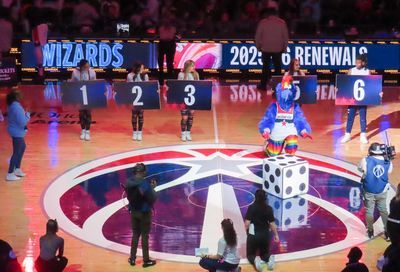Review: Bungie’s Destiny
Bungie’s newest franchise is messy and imbalanced, but still a lot of fun

Bungie is placing a lot of hope in Destiny, the latest title from the studio that gave the world Halo. That latter game, and its incredible sequel, cemented Microsoft’s Xbox as a viable third option to Sony and Nintendo in the console wars and set the basic template for every first-person shooter that followed.
After exhausting their creative juices on Halo — which is now handled by another studio — Bungie took up shop with Activision and set about creating their next magnum opus. It would be a space opera, one based in a massive, connected, constantly evolving world. It would put multiplayer at its core, blend first-person shooters with role-playing games, and offer gamers something truly deserving of the title “next gen.” It was, by all accounts, billed as the biggest new IP to hit consoles in quite some time. Activision clearly agreed, pumping $500 million dollars into the game, through development, marketing and investment in future sequels. Destiny was shaping up to be to the PS4 and the Xbox One what Halo 2 was to the original Xbox — a genre-defining, peerless experience. It’s just a shame, then, that what Bungie has ultimately delivered is a clichéd mash-up of countless other games, blended with half-baked ideas and nuggets of pure brilliance, all polished to within an inch of its life.
Let’s start with the most glaring problem Destiny faces: the story. It’s clear that a lot of effort was put into crafting its world, the lore and backstory, establishing a series of events and creating the various species and races that inhabit its world. It’s a universe rich with possibilities. Humanity’s Golden Age, brought about by a mysterious, Moon-sized entity called the Traveler, has been abruptly ended in apocalyptic style. The last remnants of civilization are gathered in one city, protected by the Traveler, as the forces of Darkness ravage the planets in our solar system. As a Guardian, resurrected by an entity known as Ghost, you are entrusted with protecting humanity’s last city and fighting back the Darkness.
Sounds pretty good, right? In principle, what Bungie has in place should make for an engrossing experience, but in practice it’s a jumbled, boring mess. The campaign is unfocused, taking place on Earth, the Moon, Venus and Mars but wasting each scenario. Every mission boils down to “fight your way to X, through wave after wave of aliens/robots/other aliens, let your Ghost scan X and gather data, head to Y or end the mission.” Missions are padded out by lengthy travel sections, and cutscenes are sparse albeit well-directed.
It doesn’t help that Destiny plays out like countless other sci-fi tales that have come before it — light versus dark, good versus evil, yadda yadda yadda — while its most interesting aspects are infuriatingly locked away. Mass Effect proved that deep lore could be blended with incredible storytelling and gameplay, with that game’s Codex feature providing quick, digestible chunks of backstory and information on the game’s characters. Bungie has obviously never heard of Mass Effect, because they instead chose to lock away Destiny’s story in Grimoire cards. These are, like the Codex, filled with bitesize pieces of information that unlock greater insight into the game’s story. They’re a necessity, as the actual story is poorly explained in-game, but Bungie stupidly trapped them on either Bungie.net or in the game’s companion app on smartphones and tablets. While playing through Destiny’s campaign, should you wish to learn more about a certain race or setting, you have to leave the game entirely to do so. Whomever came up with that genius idea needs the Old Yeller treatment.

If you need proof that Bungie threw together the game’s story missions at the last minute, consider this: there’s no achievement for finishing the game’s campaign. Bungie couldn’t care less if you finish the story — which is why completing it offers minimal reward and an unsatisfying conclusion designed to make you want a sequel, something Activision needs to justify the amount they’ve given to Bungie to make this first game.
You’ve likely bought Destiny for its main selling point. It’s designed from the ground-up as a multiplayer experience, for players to drop in and out of games with friends and strangers as they battle across the in-game world. You start by creating your Guardian, a semi-mute character who occasionally chats during the campaign, and select one of three classes: Warlock, Hunter and Titan. Warlocks are the classic wizard class, specializing in supernatural abilities, such as channeling the sun or trapping enemies in voids of power. Hunters are gunners, skilled at finding and eliminating enemies. Titans are the power class, favoring heavy weapons and bashing opponents over the head with melee attacks. I chose Warlock, but any class will offer an enjoyable, upgradeable experience. Players can also choose a race, either Human, Awoken or Exo. The latter two are races met in the campaign, with Awoken a mysterious, humanoid alien race, and the Vex an advanced, sentient robotic race. Choose whichever class you prefer — it’s purely cosmetic.
The 8 Most Anticipated Games of Fall 2014
Destiny focuses on upgrading your character, leveling up to unlock better weapons, armor, abilities and unlockables, as well as missions and multiplayer content. Killing enemies and opponents grants experience, which contributes towards your character’s level. Glimmer is the in-game currency and used to purchase armor, weapons and vehicles. Initially, Destiny is a pretty punishing game. Low-level players will have to take care in missions with low-power weapons and weak armor working against them to prevent the run-and-gun style of other shooters. You’ll have to think during some of Destiny’s heavier gunfights, and that’s not a bad thing. However, should you level up beyond the requirement of certain missions — the Moon, for instance, requires you to be level 6 or higher to play — then missions become almost laughably easy. I spent a lot of time in multiplayer and leveled up significantly, which meant by the time I was ready to tackle Destiny’s missions I was able to breeze through the entire story without breaking a sweat. Indeed, the gun awarded for completing the campaign was significantly weaker than the one I used to best it.
That imbalance is present in Destiny’s multiplayer, as well. New players will unlock the Crucible at level 6, which is where you’ll find player-versus-player combat. However, players will also find a brutally unfair system waiting for them. Destiny makes no attempts to balance its multiplayer bouts, which span the usual team deathmatch, capture-the-flag and king of the hill scenarios. Level 6 players will find themselves thrown in with those who’ve reached level 20 and higher — and there’s no standardization of weapons or powers. If you’ve gained a fully upgraded gun, powerful armor and numerous abilities in the story missions, you’ll be able to take them into the Crucible. If you’ve just started and are still relatively weak, you’d better hope you’re good at hiding. Or headshots. I regularly played with friends and all too frequently we’d find ourselves exclaiming at the game as we repeatedly shot at a high level player only for them to destroy us in one or two hits. It’s frustrating, almost to the point of quitting, which is not what you want from a game. It’s almost unthinkable, too, given how perfect Halo 2’s matchmaking was. If Bungie got it right there, why did they give up with Destiny?

Once you’ve leveled up, multiplayer opens itself up considerably. It’s fast-paced, frenetic and great fun. Bungie knows what they’re doing when it comes to crafting a first-person shooter and Destiny feels spot on. Weapons have weight to them, but movement is swift. A double-jump boost adds a dynamism to combat, sort of Titanfall-lite, while a supercharged power, which can manifest as a powerful bomb or a boost to all abilities, slowly recharges and can be unleashed with destructive force against opponents. I’ve yet to tire of multiplayer — the maps are well designed, there’s limited griefing by other players, and everything, once you get over the level imbalance, feels tight and well designed.
The same is true for Destiny’s other multiplayer elements. Playing through missions with friends, or joining them on patrols — which take place in large, open-world maps on each of the game’s visited worlds — is a blast. Arguably the most fun, and most intense, are the strikes. These hardcore missions pit groups of three players against waves of enemies and tough, powerful mini-bosses. They’re a slog to get through, can cause intense frustration as you repeatedly die, but offer incredible satisfaction when you emerge, 40 minutes later, victorious after a hard-fought battle. They’re the biggest challenge the game currently offers, and can be made even harder for those with a desire for more experience — or those with a death wish.
However, there is one huge, obnoxious, endlessly annoying inclusion that threatens to drag Destiny’s multiplayer — and indeed, the entire game — down. Loading screens. You’ll spend most of your time in Destiny in orbit around the game’s various worlds. Finish a mission? You’ll return to orbiting the planet in your ship. Need to change location? You’ll head into orbit first. Joining friends in a game? You’ll have to get there via orbit. It makes sense, disguising the game’s long loading screens by showing the travel between planets, but good God, it’s tedious. If you play through a mission on Earth, then wish to travel to the Tower — which is where Guardians receive bounty missions and can buy their tools and weapons — you’ll need to enter orbit then wait for the game to load you back down to the Tower. Both locations are on Earth, so why waste time taking me back to orbit? Why not just show a loading screen and drop me at the Tower? Nope. Instead, I have to watch my ship fly around the planet and then drop down when the location has loaded. If I want to go to another planet, I have to sit through a scene where the ship travels at light speed. Then watch as it flies over the planet. Then watch as it lands. Honestly, it’s pretty the first few times, but after a while you start to want a static loading screen with a bar. Destiny requires a lot of to-ing and fro-ing between missions — heading back to the Tower frequently to buy things, for instance — so you’ll see these loading screens constantly. Perhaps Bungie could update it to let you fly the ship around slightly as it loads. That would at least make these lengthy loading times more enjoyable to sit through.
The loading screens, as boring as they may be to sit through, are undoubtedly beautiful. Beautiful, actually, is a word that can be liberally applied to Destiny. It’s clear that the vast sums of money spent on the game have been put to good use, as it oozes style and polish from every digital pore. Every character, enemy, building, ruined location, sunrise, night sky, weapon, explosion, and power is gorgeously animated. Next gen “sheen” has been applied to every surface. The entire world practically glows it’s so shiny and fresh — even in the rust-coated Russian Cosmodrome on Earth. Destiny is an open love letter to the power of the Xbox One and PlayStation 4. It runs without a hitch, flows beautifully and will leave you in awe of its gorgeous vistas. During a multiplayer battle on Mercury, I stopped in my tracks and stared at the incredible, massive sun that burned brightly on the horizon. I took a bullet to the head, but it was worth it. Even the menus are wonderfully animated. If there were awards for polished presentation, Destiny would take them all.

That hard work continues to its sound, too. There are several well-known voice actors on board, with Peter Dinklage, Bill Nighy and Nathan Fillion just some of the voices you’ll recognize in-game. Guns, aliens, robots, scenery, wildlife and other incidental sounds are captured and reproduced brilliantly. Audio cues alerting you to certain functions — low health, nailing a precision shot, ability cooldown — are present and correct.
If it sounds like this is a mostly negative review, I feel I should state this: I have really enjoyed my time with Destiny. When you’re in the moment blasting through a seemingly impossible strike, capturing a base in multiplayer, battling waves of enemies in the campaign, it’s joyously good fun. My friends and I looked forward to jumping onto Xbox Live (my review copy was for Xbox One) to play together. However, between missions, we found ourselves all too frequently picking faults with the game. The lack of balance in multiplayer, the sheer dullness of the campaign and its unsatisfying conclusion, the idiocy of the Grimoire card system, the stupidly long loading screens. There’s a lot in Destiny that seems oddly out of place with its incredible presentation, some design and gameplay decisions which a company like Bungie shouldn’t be making. There’s also the glaring fact that so much of what Destiny does well — multiplayer gaming with friends — can be found in Bungie’s prior Halo games, all of which offer a better, more cohesive overall package.
That, really, is the problem. As good as Destiny is, and it is very good when it stops being obtuse, it’s not as good as Halo. Bungie walked away from the franchise because they were burnt out, and that’s understandable, but it begs the question: why is this subsequent game so deeply flawed in areas Bungie excelled in with their previous works? Why is the story so poorly explained with its ridiculous card system? Why does the campaign feel tacked on, despite a lot of effort being put into its backstory and setting? Why is multiplayer so punishingly unfair to begin with? Why must the game force players through so many loading hoops to move from location to location? Why, Bungie?
It could be that many of these issues will be rectified in a sequel, but that seems almost cruel given that this is a $60 game that’s available now. We’re not paying to beta test Bungie’s ideas. What makes it even more frustrating is that when Destiny is good, it’s really good. As a matter of fact, I’m going to play it when I’m finished writing this review. In two months’ time, however, when the next Call of Duty, Assassins Creed and Far Cry have launched? I’m not so sure I’ll still be dipping into Destiny’s beautiful world. What’s more, I’m not sure I’ll remember most of the features of that world. I still recall most of what happened in Mass Effect, a game that launched in 2007. I’ve already forgotten parts of Destiny’s story. Bungie has crafted a big, open, connected world — it’s just a shame that they also seem to have gotten lost in it.
Support Metro Weekly’s Journalism
These are challenging times for news organizations. And yet it’s crucial we stay active and provide vital resources and information to both our local readers and the world. So won’t you please take a moment and consider supporting Metro Weekly with a membership? For as little as $5 a month, you can help ensure Metro Weekly magazine and MetroWeekly.com remain free, viable resources as we provide the best, most diverse, culturally-resonant LGBTQ coverage in both the D.C. region and around the world. Memberships come with exclusive perks and discounts, your own personal digital delivery of each week’s magazine (and an archive), access to our Member's Lounge when it launches this fall, and exclusive members-only items like Metro Weekly Membership Mugs and Tote Bags! Check out all our membership levels here and please join us today!





















You must be logged in to post a comment.